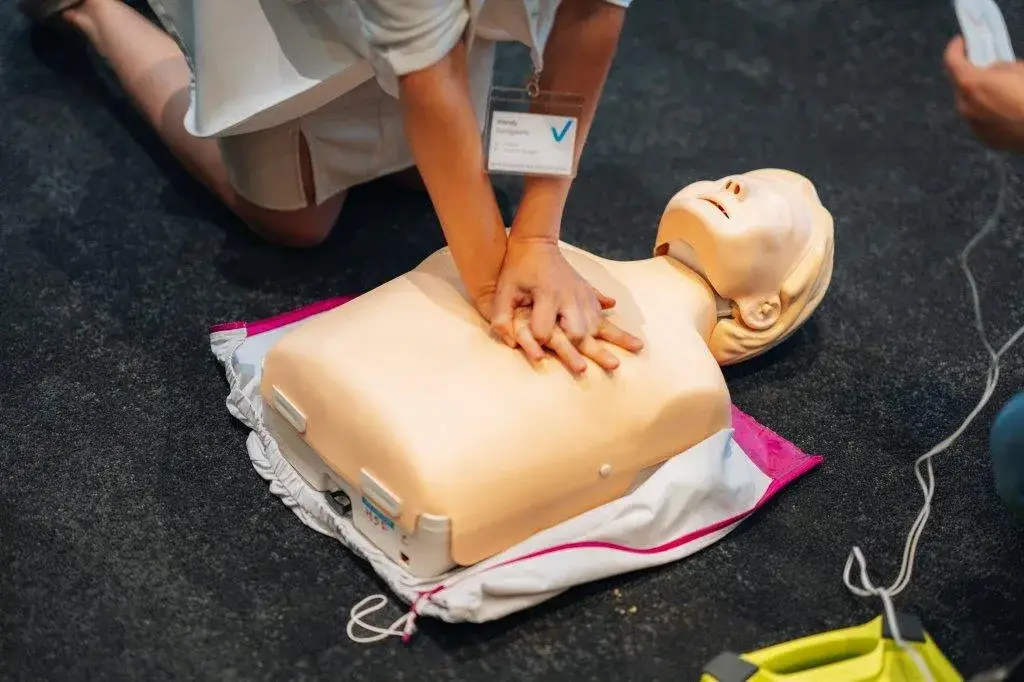Hulpverleners op het werk
Een ongeluk kan overal gebeuren.

Essentieel voor jouw EHBO-beleid
Inhoudsopgave
Een ongeluk zit in een klein hoekje. Ongevallen, incidenten en medische aandoeningen zijn soms onvermijdelijk en kunnen vaak een dramatische wending nemen. Ondanks een krachtig preventiebeleid is het onmogelijk om incidenten volledig uit te sluiten, aangezien medische noodgevallen zoals hartfalen zich onverwachts kunnen voordoen.
Als omstaander kan je het verschil maken door tijdig en gepast te reageren, waardoor de kans op een positieve afloop enorm vergroot.
Het volgen van een EHBO bedrijfshulpverlenersopleiding maakt dit proces aanzienlijk eenvoudiger. Prevom biedt zowel de basiscursus bedrijfshulpverlener (BHV) als de jaarlijkse bijscholing van 4 uur aan.
bedrijfshulpverlener worden?
EHBO-vaardigheden verwerven
De inhoud
Een basisopleiding voorziet kandidaat-hulpverleners van fundamentele kennis, aangevuld met bijscholingen en opfrismomenten.
Om optimaal te kunnen handelen in noodsituaties zijn een aantal cruciale aspecten van belang:
- Voldoende kennis van de benodigde hulp (bloedingen stelpen, reanimatie/beademing, behandeling van brandwonden, …).
- Voldoende oefening en vaardigheden om de juiste handelingen uit te voeren.
- Kalmte bewaren en de juiste prioriteiten stellen, zoals het tijdig inschakelen of contacteren van professionele hulpdiensten.
Bijscholing vormt een essentieel onderdeel van EHBO-training. Door herhaalde oefening van specifieke handelingen kan de hulpverlener zijn vaardigheden aanscherpen, waardoor hij tijdens noodsituaties efficiënter kan handelen en ondanks eventuele stress doelgericht te werk kan gaan.
Wat doet een EHBO-hulpverlener?
Een EHBO-hulpverlener biedt eerste hulp bij ongevallen, verwondingen of andere noodsituaties, ongeacht de locatie (op het werk, bij evenementen, in de fitness, in overheidsgebouwen of thuis). .
Een getrainde hulpverlener is bekwaam in het uitvoeren van essentiële handelingen en weet op welke wijze deze op een rustige en doelgerichte manier moeten worden uitgevoerd.
Enkele voorbeelden hiervan zijn:
- Het beoordelen van de situatie en het inschatten van de ernst van de verwondingen en/of de noodsituatie zelf.
- Het verlenen van eerste hulp aan slachtoffers, waaronder het aanleggen van verbanden, stabiliseren van een slachtoffer, toedienen van medicijnen, enzovoort.
- Het geruststellen van slachtoffers en het informeren van betrokkenen.
- Het contacteren en communiceren met professionele hulpdiensten zoals ambulance, politie en brandweer.
- Rapportage van het incident en bijhouden van administratie, vooral in geval van een incident op de werkvloer.
Uit de bovenstaande opsomming blijkt dat EHBO verder gaat dan alleen het aanleggen van verbanden en het plakken van pleisters. Het vervult een cruciale rol in noodsituaties waarbij er behoefte is aan een persoon die kalm blijft en zich richt op doeltreffend handelen.
Welke onderwerpen komen aan bod?
EHBO-opleidingen omvatten zowel theoretische als praktische aspecten.
Een evenwichtige combinatie van beide is vereist: men dient niet alleen de meest geschikte handeling voor een specifieke noodsituatie te kennen, maar ook in staat te zijn deze effectief en efficiënt toe te passen.
Belangrijke thema’s van zo’n opleiding zijn onder andere:
- De rol van de hulpverlener
- Voorbereiding op evacuatie of verdere procedures
- Basishygiëne en hygiënisch handelen
- Analyseren van noodsituaties
- Communicatie met professionele hulpverleners
- Vitale functies ondersteunen (ademhaling, bloedsomloop, bewustzijn)
- Handelingen bij specifieke aandoeningen (bloedingen, brandwonden, vergiftiging, hartproblemen)
De link tussen theorie en praktijk wordt gelegd door het oefenen van handelingen zoals reanimatie, verbanden aanleggen en brandwonden behandelen.
Aangepaste inhoud per sector
Volgens de Codex Boek 1 titel 5 moeten EHBO opleidingen aangepast worden aan de specifieke risico’s van een onderneming. De inhoud kan worden uitgebreid als de basisopleiding niet alle mogelijke noodsituaties dekt. Dit is vooral relevant voor sectoren met specifieke risico’s, zoals petrochemie of zware industrie.
Het is van belang kritisch te kijken naar de uitgevoerde werkzaamheden.
Enkele voorbeelden hiervan zijn:
- Blootstelling van een medewerker aan giftige of verstikkende gassen in een vloeistof/gascontainer.
- Chemische bijt- of brandwonden, waarbij sommige ernstiger kunnen worden bij spoeling met water.
- Verwondingen aan de ogen door onbeschermde blootstelling aan las- of slijpwerkzaamheden.
- Knellingen en ernstige verwondingen aan ledematen (o.a. in zware industrieën).
Iedere bedrijfstak kent unieke voorbeelden van dergelijke handelingen. Prevom, als preventiepartner, kan jouw onderneming ondersteunen door bijvoorbeeld een op maat gemaakte in-company opfrisopleiding te voorzien. Hierbij worden uitzonderlijke handelingen geïdentificeerd en opgenomen in de cursusinhoud.
Is een EHBO-hulpverlener verplicht?
Werkgevers hebben wettelijke verplichtingen om maatregelen te nemen op basis van risicoanalyses.
Dit omvat het snel verlenen van eerste hulp, alarmeren van professionele hulpdiensten en vervoeren van slachtoffers naar verzorgingslokalen of ziekenhuizen.
Het voldoen aan de wettelijke voorschriften houdt niet op bij het trainen van hulpverleners; het blijft een essentieel aspect van een sterk EHBO-beleid.
De succesformule
Bovengenoemde verplichtingen moeten eveneens kunnen toegepast worden op andere personen dan alleen medewerkers, zoals aannemers, onderaannemers en bezoekers. Om op een adequate wijze aan deze verplichtingen te voldoen, worden verschillende maatregelen genomen:
- Opleiden van medewerkers tot hulpverleners
- Naleven van de verplichte bijscholing
- Ontwikkelen van procedures op het gebied van eerste hulp
- Beschikbaar stellen van het juiste (en voldoende) EHBO-materiaal
- Indien nodig, aanvullende scholing voorzien
De correcte oplossing voor jouw bedrijf
Prevom biedt een uitgebreide reeks diensten om te voldoen aan verplichtingen voor bedrijfshulpverlening, waaronder open opleidingen, in-company opleidingen, aangepaste inhoud voor specifieke sectoren en ondersteuning bij planning en administratie.
Neem vrijblijvend contact op om de mogelijkheden te bespreken en samen een veiligere werkplek te creëren.
Op zoek naar duidelijkheid?
Moet ik als bedrijf een EHBO-hulpverlener aanstellen? Is de bijscholing verplicht? Moet ik een vooropleiding hebben?
Prevom heeft oplossingen op maat:
Wij informeren u graag over de mogelijkheden!